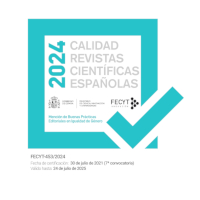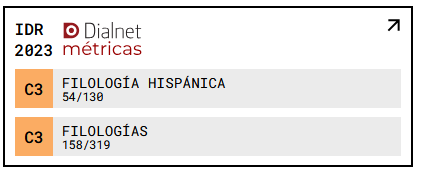El uso de la metáfora para explorar los patrones organizativos de la escritura expositiva
DOI:
https://doi.org/10.18172/cif.3635Palabras clave:
estructura textual, metáfora conceptual, escritura académica, textos argumentativos, EFLResumen
La escritura es una tarea compleja y multifacética que presenta muchos desafíos, especialmente cuando se escribe en un idioma extranjero. Estudios recientes han demostrado que tanto escritores como lectores se benefician del conocimiento explícito de los géneros textuales y de su organización, ya que el sentido de unidad de un texto está en gran parte relacionado con su estructura general. El conocimiento de la estructura del texto revela las convenciones que controlan el flujo de información y determinan los tipos de señales disponibles para los lectores. En este artículo usamos la teoría de la metáfora conceptual para proporcionar una nueva forma de explorar la escritura en el contexto académico y analizar el marco conceptual que escritores y lectores emplean para organizar la información. En este sentido, ilustramos cómo la metáfora los TEXTOS SON VIAJES puede usarse para dilucidar la organización macroestructural subyacente en textos expositivos escritos por aprendices de inglés.
Descargas
Citas
ALLBRITTON, D. W. (1995). “When metaphors function as schemas: Some cognitive effects of conceptual metaphors”. Metaphor and Symbolic Activity 10: 33-46. DOI: https://doi.org/10.1207/s15327868ms1001_4
ALLBRITTON, D. W., MCKOON, G. and GERRIG, R. J. (1995). “Metaphor-based schemas and text representations: Making connections through conceptual metaphors”. Journal of Experimental Psychology: Learning, Memory, and Cognition 21 (3): 612-625. DOI: https://doi.org/10.1037//0278-7393.21.3.612
CASTAÑO, E. (2012). The Embodied Basis of Discourse Coherence. (Unpublished doctoral dissertation). Universidad de Barcelona, Barcelona, España.
CASTAÑO, E., HILFERTY, J., and VERDAGUER, I. (2013). “The Metaphorical Basis of Discourse Structure” in Biomedical English: A Corpus-based Approach. (Eds. I. Verdaguer, N. Laso and D. Salazar). Amsterdam/New York: John Benjamins: 165-184. DOI: https://doi.org/10.1075/scl.56.09cas
DICKSON, S. V., SIMMONS, D. and KAMEENUI, E. J. (1995). “Instruction in expository text: A focus on compare/contrast structure”. LD Forum 20: 8-15.
ELBOW, P. (2006). “The music of form: rethinking organization in writing”. College Composition and Communication 57 (4): 620-666. DOI: https://doi.org/10.58680/ccc20065062
EUBANKS, P. E. (2011). Metaphor and writing: figurative thought in the discourse of written communication. Cambridge: Cambridge University Press. DOI: https://doi.org/10.1017/CBO9780511761041
FLORIS, F. D. and DIVINA, M. (2009). “A study on the reading skills of EFL university students”. TEFLIN Journal 20 (1): 37-46. DOI: https://doi.org/10.15639/teflinjournal.v20i1/37-47
FLOWER, L. and HAYES, J. (1981). “A cognitive process theory of writing”. College Composition and Communication 32: 365-87. DOI: https://doi.org/10.58680/ccc198115885
GARNHAM, A. and OAKHILL, J. V. (1996). “The mental models theory of language comprehension” in Models of Understanding Text. (Eds. B. K. Britton and A. C. Graesser). Hillsdale, New Jersey: Lawrence Erlbaum Associates: 313-339.
GENTNER, D. and GENTNER, D. R. (1983). “Flowing waters and teeming crowds: mental models of electricity” in Mental Models. (Eds. D. Gentner, and A. L. Stevens). Hillsdale, New Jersey: Lawrence Erlbaum Associates: 99-129.
GHAITH, G. M. and HARKOUSS, S. (2003). “Role of Text Structure Awareness in the Recall of Expository Discourse”. Foreign Language Annals 36 (1): 86-96. DOI: https://doi.org/10.1111/j.1944-9720.2003.tb01935.x
GOATLY, A. (1997). The Language of Metaphors. London: Routledge. DOI: https://doi.org/10.4324/9780203210000
GOLDMAN, S. R. and RAKESTRAW, J. A. (2000). “Structural Aspects of Constructing Meaning from Text” in Handbook of Reading Research. (Eds. M. L. Kamil et al.). Mahwah, New Jersey: Erlbaum: 311-336.
HAMPE, B. (Ed.) (2017). Metaphor: Embodied Cognition and Discourse. Cambridge: Cambridge University Press. DOI: https://doi.org/10.1017/9781108182324
HURTIENNE, J. and BLESSING, L. (2007). “Design for Intuitive Use - Testing image schema theory for user interface design”. 16th International Conference on Engineering Design, Proceedings of the conference 386: 1-12.
HYLAND, K. (2007). “Genre pedagogy: language, literacy and L2 writing instruction”. Journal of Second Language Writing 16 (3): 148-164. DOI: https://doi.org/10.1016/j.jslw.2007.07.005
JOHNSON, M. (1987). The Body in the Mind: The Bodily Basis of meaning, Imagination, and Reason. Chicago: University of Chicago Press. DOI: https://doi.org/10.7208/chicago/9780226177847.001.0001
KIBBLE, R. and POWER, R. (2004). “Optimizing Referential Coherence in Text Generation”. Computational Linguistics 30 (4): 401-416. DOI: https://doi.org/10.1162/0891201042544893
KIMMEL, M. (2005). “From Metaphor to the ‘Mental Sketchpad’: Literary Macrostructure and Compound Image Schemas in Heart of Darkness”. Metaphor and Symbol 20 (3): 199-238. DOI: https://doi.org/10.1207/s15327868ms2003_3
KIMMEL, M. (2008). “Image schemas in narrative macrostructure: combining cognitive linguistic with psycholinguistic approaches” in New Beginnings in Literary Studies. (Eds. W. Van Peer and J. Auracher). Newcastle: Cambridge Scholars: 158-184.
KIMMEL, M. (2013). “The conceptual metaphors of narrative structure: Gestural evidence for spatialized form in storytelling”. PJOS 5 (2): 75-123. DOI: https://doi.org/10.37693/pjos.2013.5.9761
KINTSCH, W. and VIPOND, D. (2014). “Reading comprehension and readability in educational practice and psychological theory” in Perspectives on Learning and Memory (Ed. L. G. Nilsson). New York and London: Psychology Press: 329-365.
KUSIAK-PISOWACKA, M. (2016). “Mental Model Theories in reading research and Instruction” in Working in Text and Around Text in Foreign Language Environments. (Eds. H. Chodkiewicz et al.). Switzerland: Springer International Publishing: 25-37. DOI: https://doi.org/10.1007/978-3-319-33272-7_2
LAKOFF, G. and JOHNSON, M. (1980). Metaphors We Live By. Chicago: The University of Chicago Press.
LAKOFF, G. (1987). Women, Fire, and Dangerous Things: What Categories Reveal about the Mind. Chicago: The University of Chicago Press. DOI: https://doi.org/10.7208/chicago/9780226471013.001.0001
LAKOFF, G. (1993). “The contemporary theory of metaphor” in Metaphor and Thought. (Ed. A. Ortony). Cambridge: Cambridge University Press: 202-251. DOI: https://doi.org/10.1017/CBO9781139173865.013
LAKOFF, G. (2014). “Mapping the brain’s metaphor circuitry: metaphorical thought in everyday reason”. Frontiers in Human Neuroscience 8. https://doi.org/10.3389/fnhum.2014.00958. DOI: https://doi.org/10.3389/fnhum.2014.00958
LAU, R. R. and SCHLESINGER, M. (2005). “Policy frames, metaphorical reasoning, and support for public policies”. Political Psychology 26: 77-114. DOI: https://doi.org/10.1111/j.1467-9221.2005.00410.x
MANDLER, M. J. (1986). “On the comprehension of temporal order”. Language and Cognitive Processes 1: 309-320. DOI: https://doi.org/10.1080/01690968608404680
MATSUDA, P. K., CANAGARAJAH, A. S., HARKLAU, L., HYLAND, K. and WARSCHAUER, M. (2003). “Changing currents in second language writing research: A colloquium”. Journal of Second Language Writing 12 (2): 151-179. DOI: https://doi.org/10.1016/S1060-3743(03)00016-X
MEYER, B. J. F. (1999). “The importance of text structure in everyday reading” in Understanding language understanding: Computational models of reading and understanding. (Eds. A. Ram, and K. Moorman). Cambridge, MA: MIT Press: 227-252. DOI: https://doi.org/10.7551/mitpress/6981.003.0010
MEYER, B. J. F., TALBOT, A. P., POON, L. W. and JOHNSON, M. M. (2001). “Effects of structure strategy instruction on text recall of older African American Adults” in Literacy in African Americans communities. (Eds. J. L. Harris et al.). Mahwah, New Jersey: Erlbaum: 233-263.
MEYER, B. J. F., YOUNG, C. J. and BARTLETT, B. J. (1989). Memory improved: Reading and memory enhancement across the life span through strategic text structures. New York and London: Psychology Press.
MEYER, B. J. F. and POON, L.W. (2004). “Effects of structure strategy training and signaling on recall of text” in Theoretical models and processes of reading. (Eds. R. B. Ruddell, and N. J. Unrau). Newark, Delaware: International Reading Association: 810-851.
MILLIS, K. and GRAESSER, A. C. (1994). “The time-course of constructing knowledge-based inferences for scientific texts”. Journal of Memory and Language 33: 583-599. DOI: https://doi.org/10.1006/jmla.1994.1028
MULDER, G. (2008). Understanding causal coherence relations. (Unpublished doctoral dissertation). Utrecht: Landelijke Onderzoekschool Taalwetenschap.
MURRAY, J. D. (1997). “Connectives and narrative text: The role of continuity”. Memory and Cognition 25: 227-236. DOI: https://doi.org/10.3758/BF03201114
PEARSON, P. and RAPHAEL, T. (1990). “Reading comprehension as a dimension of thinking” in Dimensions of thinking and cognitive instruction: Implications for reform. (Eds. B. F. Jones, and L. I. Idol). Hillsdale New Jersey: Lawrence: 209-240.
PEÑA CERVEL, M. S. (2011). “Macbeth Revisited: A cognitive analysis”. Metaphor and Symbol 26: 1-22. DOI: https://doi.org/10.1080/10926488.2011.535412
PONTEROTTO, D. (2003). “The cohesive role of cognitive metaphor in discourse and conversation” in Metaphor and Metonymy at the Crossroads. A Cognitive Perspective. (Ed. A. Barcelona). Berlin: Mouton de Gruyter: 283-298. DOI: https://doi.org/10.1515/9783110894677.283
PONTEROTTO, D. (2007). “Conceptual Metaphor and Text Development: a Narratological Perspective”. Cultural Studies Journal of Universitat Jaume I 5: 59-73.
RAPHAEL, T. E. and ENGLERT, C. S. (1990). “Writing and reading: Partners in constructing meaning”. The Reading Teacher 43: 388-400.
RICHARDSON, J. and MORGAN, R. (2003). Reading to Learn in the Content Areas. Belmont, CA: Thomson-Wadsworth.
ROBINS, S. and MAYER, R. E. (2000). “The metaphor framing effect: Metaphorical reasoning about text-based dilemmas”. Discourse Processes 30: 57-86. DOI: https://doi.org/10.1207/S15326950dp3001_03
SALMANI-NODOUSHAN, M. A. (2010). “The impact of formal schemata on L3 reading recall”. International Journal of Language Studies (IJLS) 4 (4): 357-372.
SANDERS, T. J. M. and SCHILPEROORD, J. (2006). “Text structure as a window on the cognition of writing; How text analysis provides insights in writing products and writing processes” in Handbook of Writing Research. (Eds. C. MacArthur; S. Graham, and J. Fitzgerald). New York: Guilford Press: 386-402.
SANDERS, T., SPOOREN, W. and NOORDMAN, L. (1993). “Coherence Relations in a Cognitive Theory of Discourse Representation”. Cognitive Linguistics 4 (2): 93-133. DOI: https://doi.org/10.1515/cogl.1993.4.2.93
SANDERS, T. and NOORDMAN, L. G. M. (2000). “The role of coherence relations and their linguistic markers in text processing”. Discourse Processes 29: 37-60. DOI: https://doi.org/10.1207/S15326950dp2901_3
SCHOONEN, R., SNELLINGS, P., STEVENSON, M. and VAN GELDEREN, A. (2009). “Towards a blueprint of the foreign language writer: The linguistic and cognitive demands of foreign language writing” in Writing in foreign language contexts: Learning, teaching and research. (Ed. R. M. Manchón). Bristol/Buffalo/Toronto: Multilingual Matters: 77-101. DOI: https://doi.org/10.21832/9781847691859-007
SEMINO, ELENA. (2008). Metaphor in Discourse. Cambridge: Cambridge University Press. DOI: https://doi.org/10.1017/CBO9780511816802.015
SERIG, D. (2008). “Understanding the conceptual landscape of visual metaphor”. Teaching Artist Journal 6 (1): 41-50. DOI: https://doi.org/10.1080/15411790701678408
SINGER, M. and GAGNON, N. (1999). “Detecting causal inconsistencies in scientific text” in Narrative comprehension, causality, and coherence: Essays in honor of Tom Trabasso. (Eds. S. R. Goldman, A. Graesser, and P. van den Broek). Mahwah, New Jersey: Lawrence Erlbaum Associates, Inc.: 179-194.
TALMY, L. (2000). Toward a Cognitive Semantics, vol. I. Cambridge: The Mitt Press. DOI: https://doi.org/10.7551/mitpress/6847.001.0001
THIBODEAU, P. H. and BORODITSKY, L. (2011). “Metaphors we think with: the role of metaphor in reasoning”. PLoS ONE 6 (2): e16782. DOI: https://doi.org/10.1371/journal.pone.0016782
THIBODEAU, P. H. and BORODITSKY, L. (2013). “Natural language metaphors covertly influence reasoning”. PLoS ONE 8 (1): e52961. DOI: https://doi.org/10.1371/journal.pone.0052961
TOBIN, L. (1989). “Bridging Gaps: Analyzing Our Students’ Metaphors for Composing”. College Composition and Communication 40 (4): 444-458. DOI: https://doi.org/10.58680/ccc198911113
TOMLINSON, B. (2005). Authors on writing: Metaphors and intellectual labor. Houndmills, Basingstoke, Hampshire; New York: Palgrave Macmillan. DOI: https://doi.org/10.1057/9780230595668
TRABASSO, T., SECCO, T. and VAN DEN BROEK, P. W. (1984). “Causal cohesion and story coherence” in Learning and comprehension of text. (Eds. H. Mandler, N. L. Stein, and T. Trabasso). Hillsdale, NJ: Erlbaum: 83-111.
VAHIDI, S. (2008). “The impact of EFL learners’ rhetorical organization awareness on English academic/expository text comprehension”. Pazhuhesh– e Zabanha–ye Khareji 41: 145-158.
VIRTUE, S., VAN DEN BROEK, P. and LINDERHOLM, T. (2006). “Hemispheric processing of inferences: The effects of textual constraint and working-memory capacity”. Memory and Cognition 34 (6): 1341-1354. DOI: https://doi.org/10.3758/BF03193276
WONG, B.Y.L. (2000). “Writing strategies instruction for expository essays for adolescents with and without disabilities”. Topics in Language Disorders 20: 29-44. DOI: https://doi.org/10.1097/00011363-200020040-00005
YOUNG, T. A. and HADAWAY, N. L. (Eds.) (2006). Supporting the literacy development of English learners: Increasing success in all classrooms. Newark, DE: International Reading Association.
ZWAAN, R. and RADVANSKY, G. (1998). “Situation models in language comprehension and memory”. Psychological Bulletin 123 (2): 162-185. DOI: https://doi.org/10.1037//0033-2909.123.2.162
ZWAAN, R. A. and SINGER, M. (2003). “Text comprehension” in Handbook of discourse processes. (Eds. A.C. Graesser, M. A. Gernsbacher and S. R. Goldman). Mahwah, New Jersey: Erlbaum: 83-121.
Descargas
Publicado
Cómo citar
Número
Sección
Licencia
El autor o autora conserva todos los derechos sobre su artículo y cede a la revista el derecho de la primera publicación, no siendo necesaria la autorización de la revista para su difusión una vez publicado. Una vez publicada la versión del editor el autor está obligado a hacer referencia a ella en las versiones archivadas en los repositorios personales o institucionales.
El artículo se publicará con una licencia Creative Commons de Atribución, que permite a terceros utilizar lo publicado siempre que se mencione la autoría del trabajo y la primera publicación en esta revista.
Se recomienda a los autores/as el archivo de la versión de editor en repositorios institucionales.














